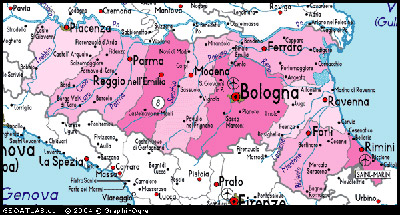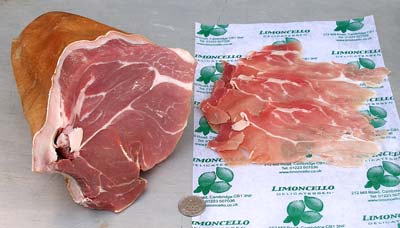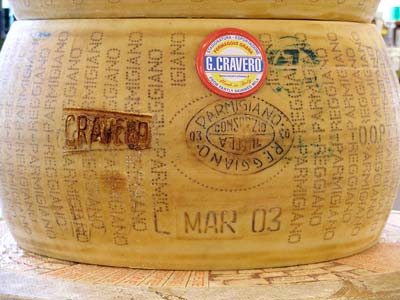
Parma is a province and town of Emilia-Romagna, a region stretching from San Marino and Ravenna in the east to Piacenza in the west. It lies on the fertile alluvial plains of the Po, just below the foothills of the Appenines. Maize and wheat are grown in the vicinity, the maize being used to fatten the cattle whose milk is turned into the famed Parmesan cheese. The whey is fed to the pigs, whose meat is turned into Parma hams and culatello. Even the chickens do not escape this wonderful cycle of production, being fed on maize to ensure that the whites have the correct consistency for making hard white semolina pasta and the yolks have a rich yellow colour.

Parma ham from Emilia-Romagna is a cured, raw ham which is hung to dry in long cool caves in the vicinity of Parma for 14-16 months.This produces sweet, tender ham with pink flesh marbled with white fat. The best are stamped with a ducal crown to show they meet the approval of the inspectors.
A dish of cardoons fried and then baked with tomato sauce, mozzarella, garlic and basil and, traditionally, not Parmesan cheese.
A classic southern Italian dish of aubergine (US: eggplant) fried and then baked with tomato sauce, mozzarella, garlic and basil and, traditionally, not Parmesan cheese.
A dish of courgettes (US: zucchini) fried and then baked with tomato sauce, mozzarella, garlic and basil and, traditionally, not Parmesan cheese.

Parmesan cheese (PDO). A well-known, high quality, very hard, grana cow's milk cheese from Modena, made around Parma since the 17th in its present form, and recorded as early as the Decameron in the 14th C. It has a brittle amber coloured paste with white speckles and flakes called snowflakes. It is made in an 18 month process unchanged for 3 centuries. Parmigiano Reggiano is the authentic one, like the difference between Brie de Meaux and Brie. It is made in barrel shapes weighing 35 kg (77 lb), which are salted and which bear the name and date etched in perforated lettering on a light brown rind. Only about 2½ million are made each year. It has no additives other than salt and rennet.
A type of pasta. This is a common American spelling of the more correct "pappardelle" of Italy. Pappardelle are wide ribbons made from egg pasta, a little wider than fettuccine or taglietelle, sometimes with wavy edges, often served with game sauce or rich meat sauces in Tuscany or Umbria.